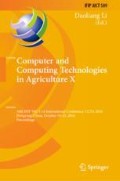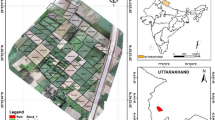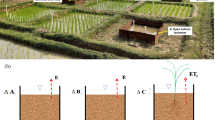Abstract
This research utilized “GaoFen-1” 2 m panchromatic, 8 m and 16 m multispectral satellite data to monitor the planting area of winter wheat. Calculate the correction coefficient by the results of planting area of winter wheat gotten from “GaoFen-1” 16 m multispectral satellite data and micro unmanned aerial vehicle data. Correct the area extraction result of “GaoFen-1” 16 m multispectral satellite data and verify the accuracy of the results got from fusion data of 2 m resolution and 8 m resolution of “GaoFen-1” by micro unmanned aerial vehicle data. Then compare with the area extraction results, extracted from the data of fusion data of 2 m resolution and 8 m resolution of “GaoFen-1” and the corrected 16 m multispectral satellite data, in Jizhou. The study result show that the corrected extraction result of planting area of winter wheat, from “GaoFen-1” 16 m multispectral satellite data, is accurate relatively and could better meet the requirements of the crop dynamic monitoring business operational running.
Y. Liu—Member of Chinese Commission of Agricultural Engineering, the practice of land use and agricultural remote sensing.
Similar content being viewed by others
Keywords
Following the development of remote sensing technology, various types of remote sensing data were applied to monitor planting area of crops. There are several advantages of remote sensing technology, such as timeliness and objectivity, which could meet multi level requirements of agricultural. Wang et al. [1], based on the data of SPOT4, extracted the planting area of winter white for calculating the inter annual variation of area. Wang et al. [2], monitored winter wheat area in Henan with the free data of HJ-1satellite CCD. Hao et al. [3], Used MODIS data to extract the planting area of Winter Wheat in the North China Plain in 2009. And the HJ-1 satellite classification data gained from multi temporal phase in the same year were used as the reference value to verify the results. Liu et al. [4], used high resolution remote sensing image RapidEye to extract crop planting area. At the same time calculated correction coefficient by the ground samples to correct area extraction results.
On one hand, in previous studies, the researchers used a variety of remote sensing data sources (such as RapidEye, SPOT, HJ-1 CCD, MODIS, etc.) on different scales to monitor the planting area of crops. Using low resolution remote sensing images can effectively improve the time resolution and reduce the cost, but which would generate large number of mixed pixel to decrease the ability of spectrum identification to affect the accuracy of the crop planting area extraction. In contrast, using in high resolution remote sensing image extraction of crop acreage, to obtain more color, texture, shape and other characteristics of information, object recognition is higher, but affected by the revisit time length and single image coverage and other factors, the number and coverage of data acquisition were greatly restricted, and the cost of data was higher, and the applicability of the crop dynamic monitoring business operational running is not well. On the other hand, some researchers used ground samples to correct area extraction results had slightly insufficiency. Covering an area of ground sample is usually small. Correct interpretation results using a limited number of samples, couldn’t meet the requirements to improve the overall accuracy.
China high-resolution earth observation system satellite 1 (Hereinafter referred to as “GF-1”) set with blue, green, red and near infrared four bands, in terms of spatial resolution, revisit time length and single image coverage has comprehensive advantages. GF-1 data can very good solve rapid data acquisition, single image to cover a wider range, improve the object recognition, and other issues at the same time. The small size and low cost micro unmanned aerial vehicle information acquisition technology platforms (Hereinafter referred to as “micro-UAV”) have been widely applied in agricultural field in recent years. It could offer a fast and flexible way to acquire data for crop management and monitoring, and is capable of rapidly provision of high resolution images. At the same time Micro-UAV will be able to collect a larger range of data, and the accuracy of data is similar as ground sampling data.
Based on the above, this study illustrate by a case of Jizhou in Hebei province, use GF-1 data to monitor the planting area of winter wheat, and then use the UAV data to modify the area extraction results to solve the problem of mutual restriction between precision and cost and provide scientific basis for the development of operational monitoring in a large scale.
1 Study Area and Data
1.1 Research of Regional
Jizhou city is continental monsoon climate characteristics significantly, with four distinct seasons, rain and heat over the same period. Flat terrain and suitable soil, is benefiting to the cultivation of food crops. The major food crops include winter wheat and corn in Jizhou. The location map of Jizhou is shown in Fig. 1.
1.2 Data Acquiring and Data Preprocessing
1.2.1 Remote Sensing Data Acquiring
GF-1 is a satellite with 2-m resolution CCD camera, and an 8-m resolution multi-spectrum imager, and a 16-m resolution wide-field multi-spectrum imager while covering an area of 800 km. It means that GF-1 can observe the whole globe within 4 days. Winter wheat biomass was relatively stable during the winter, the spectral features presented on the satellite images are obviously, and less vegetation types in winter. So this study chose the fusion data of 2 m resolution and 8 m resolution of GF-1 (Hereinafter referred to as “GF2m”), and chose GF-1 16 m resolution data (Hereinafter referred to as “GF16m”). The two kinds of GF-1 data were in 2015. On the basis of visual pre judgment of crop planting in Jizhou city, arranged some ground sample area in the cultivated land uniformly, and then collected distribution information data of ground objects in the ground sample area by micro-UAV for correcting the extraction results of planting area of winter wheat. The remote sensing data acquisition is shown in Table 1.
1.2.2 Ground Survey Data Acquisition
Acquired crops, leisure farmland, saplings and other key features of the interpretation signs information by GPS in the study area and investigated the situation of crops in the region.
1.2.3 Data Preprocess
Geometric correction, projection conversion, image mosaic and cropping the data of GF2m, GF16m and micro-UAV are carried. GF-1 data coverage is shown in Fig. 2 and micro-UAV data distribution is shown in Fig. 3.
2 Research Method
Combining with the computer auto-classification and manual visual interpretation as a method and basing on the information came from ground investigation to extract the planting area of winter wheat from the GF16m, GF2m and micro-UAV data of Jizhou city for 2015 years. Calculate the correction coefficient by the results of planting area of winter wheat gotten from GF16m and micro-UAV data. Correct the extraction result of planting area of winter wheat. Calculate accuracies of the results in GF2m and GF16m, combining with the data of micro-UAV. Using GF2m data of winter wheat planting area extraction results to verify the accuracy of winter wheat planting area before and after the correction for evaluating the capability of the method combined with GF16m and micro-UAV data in operational running monitoring.
2.1 The Establishment of Interpretation Symbols
Basing on the ground investigation and analyzing the satellite image, established the interpretation symbols database about the GF16m and micro-UAV data. On different data types, the color of the ground object is different. Such as in the GF16m image data, winter wheat show orange and dark red and mixed with light gray and slightly rough texture; Leisure cultivated land has pale orange yellow and sky blue; woodland showed reddish brown and black purple. In the GF2m image data, Winter wheat were presented in red and pink, mixed with dark red; leisure cultivated showed gray blue and gray green; woodland showed strip sky blue and red and pink and purple and pink and pink. In the micro-UAV image data, winter wheat is red; leisure cultivated presents gray blue, mixed with white stripes; woodland showed blue black, gray with blue stripes. Interpretation symbols of key features of Jizhou city is shown in Table 2.
2.2 Correction Coefficient
Using the results of planting area of winter wheat got from micro-UAV and GF16m data, calculate the correcting factor. The result of planting area got from GF16m data should intercept the same region to each micro-UAV data’s coverage.
R-GF16m: The result of planting area of winter wheat got from GF16m data with the same scope as micro-UAV data’s coverage.
R-UAV: The result of planting area of winter wheat got from Micro-UAV.
The correction coefficient is more than 1 value, indicates that there are errors that interpretation planting area of winter wheat is too much in the data of GF16m. The greater the correction coefficient is, the lower the accuracy of interpretation.
The correction coefficient is less than 1 value, indicates that there are errors that interpretation planting area of winter wheat is missed. The more close to the 0 value of the correction coefficient, the lower the accuracy of interpretation.
The more close to the 1 value of the correction coefficient, indicates that the accuracy of the interpretation planting area of winter wheat is higher.
3 The Planting Area Monitoring Results and Analysis
3.1 Calculation of Correction Coefficient of GF16m Data
According to the formula (1), combined with data of Micro-UAV and the data of GF16m and GF2m, corresponding to the location of sample area of each data of Micro-UAV, to calculate the correction coefficient. Then calculate the average value of correction coefficient of every sample’s, as the correction coefficient final value of extraction result of planting area of winter wheat in Jizhou of the data of GF16m. And calculate the average value of accuracy of every sample’s separately, as the accuracy final value of extraction result of planting area of winter wheat in Jizhou of the data of GF16m and GF2m. Table 3 shows that the correction coefficient of final value GF16m is 1.2105. The accuracies of the two kinds of GF-1 data(GF2m and GF16m)are 96.62% and 82.73%. Figure 4 shows a part of the same area of the interception of UAV data and GF-1 data extraction results. As can be seen from the Fig. 4 and the Table 3, the extraction results of winter wheat planting area of the GF2m data are close to the results of the UAV data. Therefore, the study uses the result of GF2m data as the true value of planting area of winter wheat in Jizhou.
3.2 Analysis of Monitoring Results of Planting Area
Table 4 shows that the uncorrected extraction result of planting area of winter wheat is 34804.5 ha, and the corrected extraction result of planting area of winter wheat is 27478.2 ha, two results both came from the data of GF16m in Jizhou. The result of planting area of winter wheat, extracted by the data of GF2m in Jizhou is 29329.3 ha. The results show that the result of corrected extraction area of GF16m data is closing to the result of GF2m.
4 Conclusion
Comparing with the results of planting area extraction of winter wheat in the data of GF16m and GF2m, it can be found that the corrected extraction result of planting area of winter wheat, from the data of GF16m, is accurate relatively. At the same time, comparing to the data of GF2m, the data of GF16m has shorter revisit period and greater coverage. GF16m can be better to avoid the problem of less data abstention, in a limited period of crop growth, caused by the reasons of weather. It could better meet the requirements of the crop dynamic monitoring business operational running.
References
Wang, D., Zhou, Q.B., Liu, J.: Studies on experiment of optimizing design of space sampling frame and sampling basic elements of crop areas. J. China Agric. Resour. Reg. Plan. 29(4), 9–15 (2008)
Wang, L.G., Zheng, G.Q., Chen, H.L., Zou, C.H., Liu, Z.Y., Cheng, Y.Z.: Monitoring the change of global winter wheat planting area in Henan province based on HJ-CCD image. J. China Agric. Resour. Reg. Plan. 32(2), 58–62 (2001)
Hao, L.Y., Sun, R., Xie, D.H., Tang, Y., Wang, Y.: Planting area extraction of winter wheat in north China plain based on optimized N-FINDR algorithm. Trans. Chin. Soc. Agric. Eng. 29(15), 153–161 (2013)
Liu, K.B., et al.: Extraction on cropping structure based on high spatial resolution remote sensing data. J. China Agric. Resour. Reg. Plan. 35(1), 21–26 (2014)
Author information
Authors and Affiliations
Corresponding author
Editor information
Editors and Affiliations
Rights and permissions
Copyright information
© 2019 IFIP International Federation for Information Processing
About this paper
Cite this paper
Liu, Y., Jiao, W., Wang, H., Han, X. (2019). Application of “GaoFen-1” Satellite Data and “Micro-UAV” Data in Remote Sensing Monitoring in Winter Wheat—Illustrated by a Case of Jizhou in Hebei Province. In: Li, D. (eds) Computer and Computing Technologies in Agriculture X. CCTA 2016. IFIP Advances in Information and Communication Technology, vol 509. Springer, Cham. https://doi.org/10.1007/978-3-030-06155-5_3
Download citation
DOI: https://doi.org/10.1007/978-3-030-06155-5_3
Published:
Publisher Name: Springer, Cham
Print ISBN: 978-3-030-06154-8
Online ISBN: 978-3-030-06155-5
eBook Packages: Computer ScienceComputer Science (R0)










